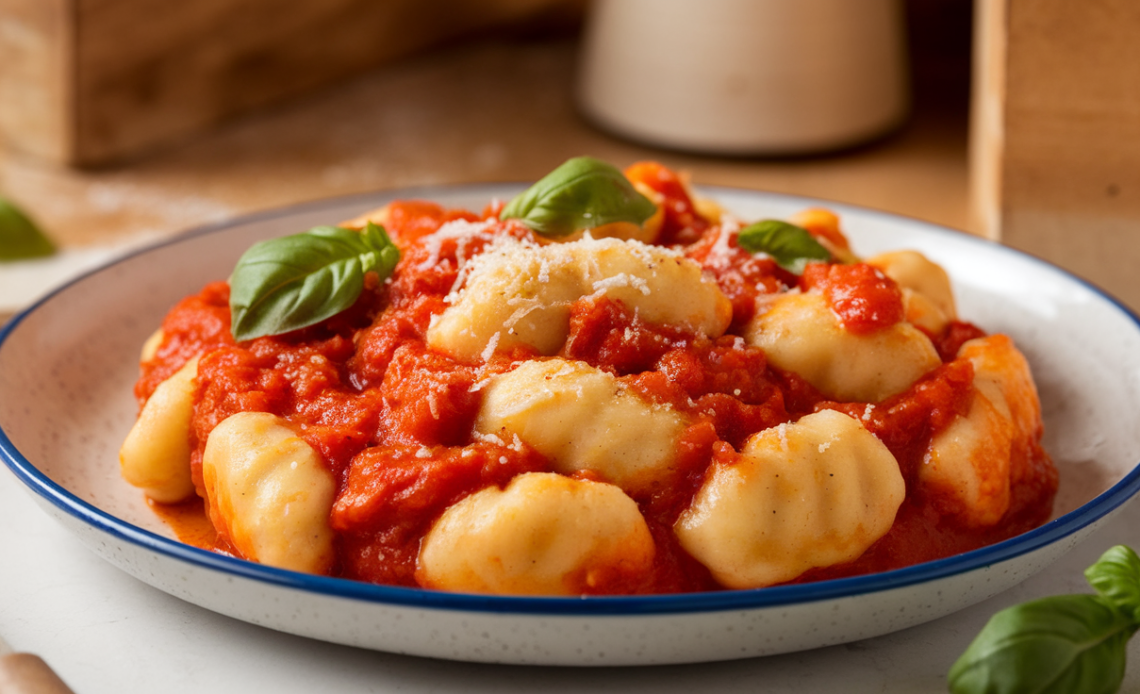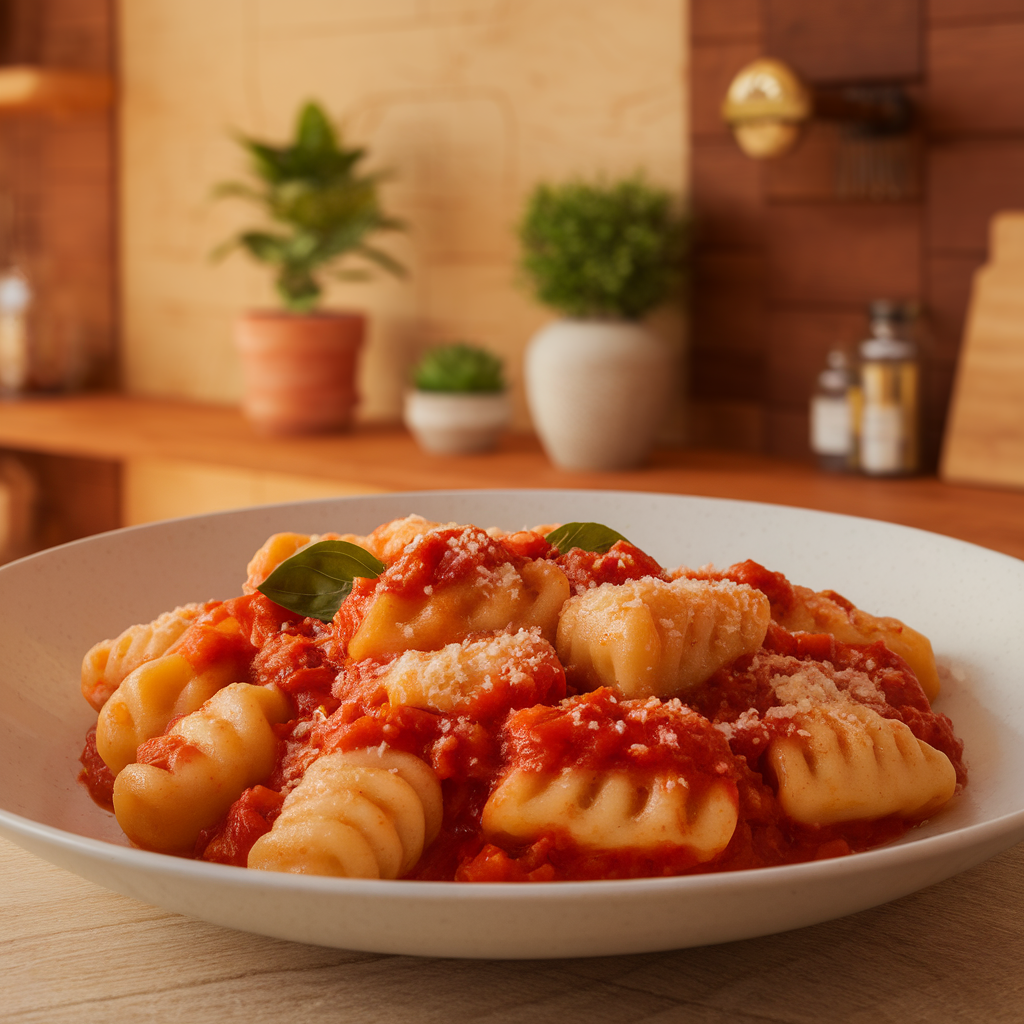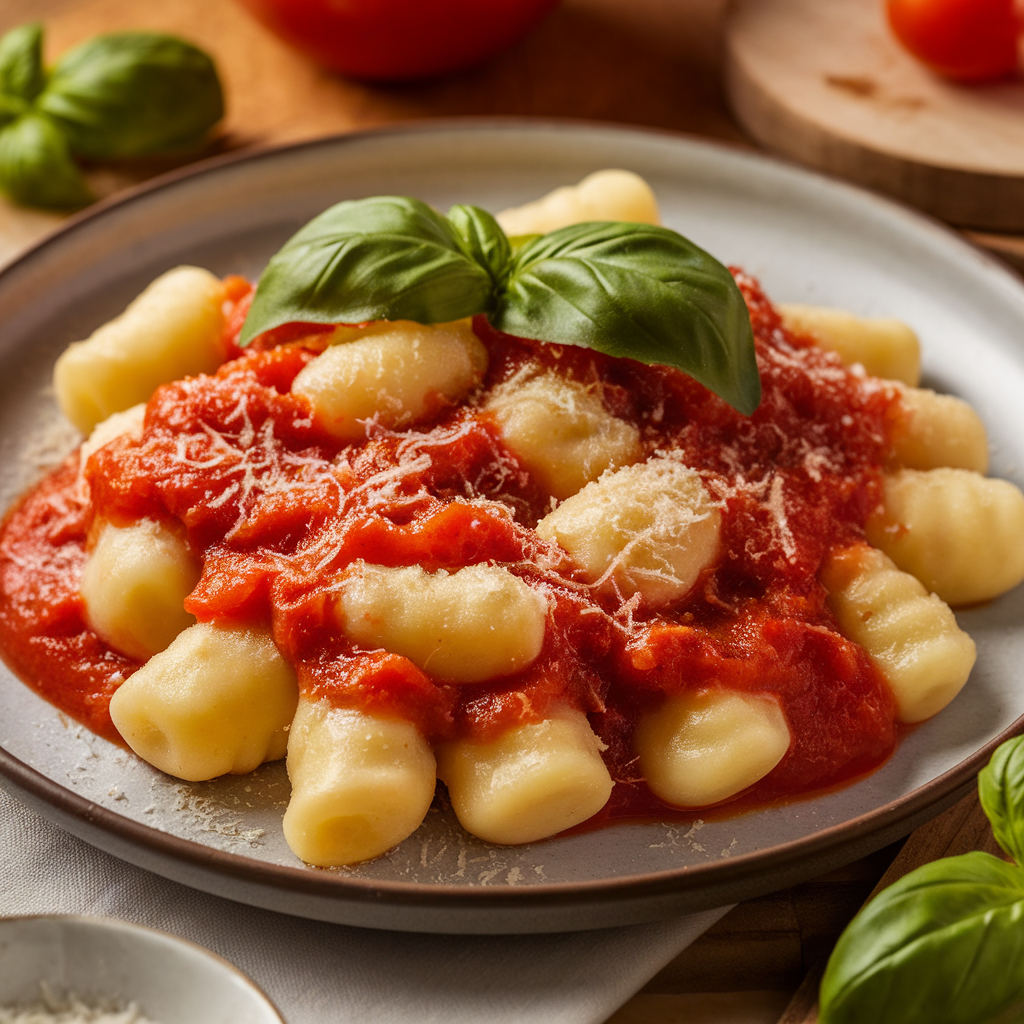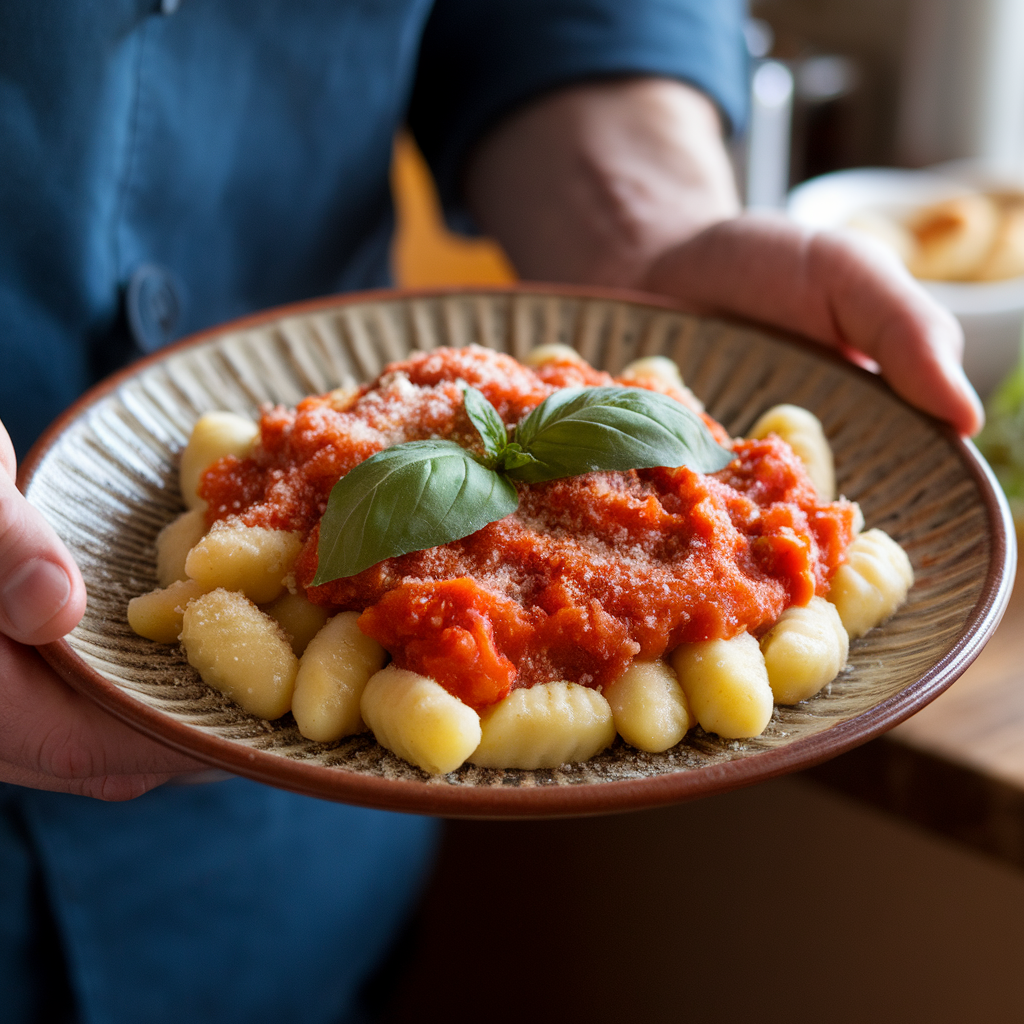
Gnocchi with pomodoro sauce is a quintessential Italian dish that beautifully blends tender, pillowy potato gnocchi with the bright, fresh flavors of a traditional pomodoro sauce — a simple yet aromatic easy tomato sauce crafted from ripe tomatoes, garlic, olive oil, and fresh basil. It stands as one of the most beloved and comforting dishes in Italian cuisine, representing the perfect harmony between rustic simplicity and refined flavor.
If you’ve been searching for the best gnocchi recipes or want to master the art of pairing potato gnocchi sauce with fresh tomato goodness, you’ve come to the right place. This comprehensive guide will walk you through the entire process—from making tender gnocchi from scratch, to crafting a luscious pomodoro sauce, along with expert tips, variations, and serving suggestions for an authentic Italian meal that’s perfect any day of the week.
What Are Gnocchi?
The word “gnocchi” (pronounced “nyoh-kee”) refers to small, soft dumplings traditionally made from a combination of mashed potato, flour, and eggs. Unlike pasta, gnocchi offer a distinct texture — delicate, fluffy, and almost cloud-like — making them one of the most comforting dishes you can prepare. Originating from Italy, gnocchi come in many regional variations: some made with ricotta, others with semolina or even spinach. But the most classic and widely enjoyed version is the potato gnocchi.
Gnocchi dough is incredibly forgiving but requires a delicate hand. The balance of flour and potato is essential to achieve soft, tender gnocchi without becoming dense or gummy. Once cooked, gnocchi gently float to the surface of boiling water — a sign they’re ready to be savored.
The Heart of the Dish: Pomodoro Sauce
“Pomodoro” literally means “tomato” in Italian, and pomodoro sauce is the epitome of simplicity and freshness in Italian cooking. Unlike heavy meat-based ragùs or creamy sauces, pomodoro sauce highlights the natural sweetness and acidity of ripe tomatoes with just a few complementary ingredients:
- Olive oil lends richness and smoothness.
- Garlic infuses a warm, aromatic base.
- Fresh basil adds a fragrant, herbaceous note.
- Salt, pepper, and a pinch of sugar balance the flavors.
This sauce is light enough to allow the tender gnocchi to shine, yet flavorful enough to make every bite memorable. It’s considered one of the best pasta sauces because it’s so versatile, easy to prepare, and universally loved.

Ingredients: Quality Matters
For the Potato Gnocchi:
- Russet or Yukon Gold potatoes (about 2 pounds/900g): Starchy potatoes create the fluffiest gnocchi.
- All-purpose flour (1 to 1 ½ cups/120-180g): Provides structure; avoid overusing.
- 1 large egg: Binds the dough, adding richness and elasticity.
- Salt (1 tsp): Enhances flavor.
For the Pomodoro Sauce:
- Extra virgin olive oil (3 tbsp): Use the best quality for flavor and health benefits.
- Garlic (4 cloves): Thinly sliced or minced to infuse the sauce.
- Ripe tomatoes (fresh or canned San Marzano, 28 oz/800g): San Marzano tomatoes are prized for their balanced sweetness and low acidity.
- Salt and freshly ground black pepper: To taste.
- Sugar (optional, 1 tsp): To balance acidity if tomatoes are tart.
- Fresh basil leaves: Torn or chopped, added at the end for fragrance.
- Parmesan cheese: Freshly grated, for serving.
Step-by-Step: How to Make Potato Gnocchi
1. Cook the Potatoes Properly
- Baking Method: Baking whole potatoes dries them out slightly, concentrating starches for lighter dough. Wrap potatoes in foil and bake at 400°F (200°C) for 60 minutes until tender.
- Boiling Method: Peel and boil potatoes until fork-tender (30-40 minutes). Drain and dry on low heat in the pot to remove excess moisture.
2. Mash the Potatoes
- Use a potato ricer or food mill for the smoothest mash — this avoids lumps and yields light gnocchi.
- Work quickly while potatoes are warm to incorporate the egg and flour efficiently.
3. Prepare the Dough
- On a clean surface, mound the mashed potatoes.
- Sprinkle salt and flour over the potatoes, creating a well in the center.
- Add the beaten egg to the well.
- Gently fold everything together with your hands until a cohesive dough forms.
- Avoid kneading too much to prevent tough gnocchi.
4. Shape the Gnocchi
- Divide the dough into four pieces.
- Roll each piece into a ¾-inch thick rope.
- Cut into 1-inch pieces.
- Optionally, roll each piece over the back of a fork or gnocchi board to create ridges, helping sauce adhere better.
5. Cook the Gnocchi
- Bring a large pot of salted water to boil.
- Cook gnocchi in batches, stirring gently.
- Gnocchi are done when they float to the surface (about 2-3 minutes).
- Remove with a slotted spoon and drain.

How to Make Classic Pomodoro Sauce
1. Sauté Garlic
- Heat olive oil over medium heat.
- Add sliced garlic, sauté until fragrant and golden (1-2 minutes).
- Avoid burning to prevent bitterness.
2. Add Tomatoes
- Add canned whole San Marzano tomatoes or fresh peeled and chopped tomatoes.
- Break down canned tomatoes by hand or with a spoon.
3. Simmer the Sauce
- Let sauce simmer uncovered for 20-30 minutes.
- Season with salt, pepper, and sugar if tomatoes are too acidic.
- Stir occasionally to prevent sticking.
4. Finish with Basil
- Remove from heat.
- Stir in fresh torn basil leaves to preserve aroma and freshness.
Bringing It Together: Serving Your Gnocchi With Pomodoro Sauce
- Transfer cooked gnocchi to the skillet with pomodoro sauce.
- Toss gently to coat every gnocchi piece with luscious sauce.
- Serve immediately.
- Garnish with grated Parmesan cheese and additional basil leaves.
Expert Tips for the Best Gnocchi and Pomodoro Experience
- Choose the right potatoes: Russets yield fluffy gnocchi; waxy potatoes make them gummy.
- Avoid over-flouring: Use just enough flour to bring dough together; too much makes gnocchi heavy.
- Handle dough lightly: Knead just enough to combine ingredients.
- Don’t rush the cooking: Cook gnocchi in small batches.
- Use quality olive oil: It enhances both sauce and gnocchi flavor.
- Fresh tomatoes or canned: San Marzano canned tomatoes provide authentic taste year-round.
- Taste and adjust seasoning: Balance acidity with sugar as needed.
Nutritional Highlights
- Gnocchi is a good source of carbohydrates and energy.
- Pomodoro sauce is rich in antioxidants like lycopene from tomatoes.
- Olive oil provides heart-healthy monounsaturated fats.
- Basil adds vitamins and minerals while enhancing flavor naturally.
- Moderation is key; this dish can fit into balanced diets when paired with vegetables or salads.
Variations to Elevate Your Gnocchi Dishes
- Creamy Pomodoro: Add a splash of cream or mascarpone cheese to pomodoro for richness.
- Garlic Butter Finish: After boiling, sauté gnocchi briefly in garlic butter before adding sauce.
- Vegetable Boost: Add sautéed mushrooms, zucchini, or spinach to the sauce.
- Spicy Pomodoro: Include red chili flakes for heat.
- Pesto Pomodoro Fusion: Stir in fresh basil pesto for herbal complexity.
- Cheese Variations: Try Pecorino Romano or a mixture of Parmesan and Grana Padano.

How to Store and Reheat Gnocchi With Pomodoro Sauce
- Gnocchi: Refrigerate cooked gnocchi in airtight container for 2 days. Reheat by gently warming in sauce or buttered pan.
- Pomodoro Sauce: Keep refrigerated for up to 5 days or freeze for 3 months.
- Avoid overcooking on reheating to preserve gnocchi texture.
Serving Suggestions to Complete Your Meal
- Crisp green salad with lemon vinaigrette.
- Garlic bread or rustic Italian focaccia.
- Roasted vegetables like asparagus or bell peppers.
- Light Italian white or red wines, such as Pinot Grigio or Chianti.
Frequently Asked Questions (FAQs)
Can I use store-bought gnocchi?
Yes! While homemade gnocchi has unmatched texture, quality store-bought gnocchi pair wonderfully with pomodoro sauce.
What if my dough is sticky or falls apart?
Add flour sparingly and mix gently. If it’s too sticky, refrigerate dough wrapped in plastic for 15-20 minutes to firm up.
How do I peel fresh tomatoes easily?
Score tomatoes, blanch in boiling water for 30 seconds, transfer to ice bath, then peel skins off effortlessly.
Can I make gnocchi without egg?
Yes, egg is optional but helps bind dough. Eggless gnocchi are common in some regions, but texture may be different.
The History and Cultural Significance of Gnocchi and Pomodoro Sauce
Gnocchi dates back to Roman times, evolving over centuries into many regional variations throughout Italy. The potato version became popular after potatoes were introduced to Europe in the 16th century. Pomodoro sauce gained prominence in Naples and became a staple of southern Italian cuisine, prized for its fresh, straightforward flavor profile. Together, they epitomize Italian culinary philosophy: simple ingredients prepared with love and respect.
Final Thoughts: Why Gnocchi With Pomodoro Sauce Should Be Your Next Homemade Meal
With its tender mashed potato base, fluffy texture, and fresh, zesty tomato sauce gnocchi topping, this dish perfectly marries comfort with elegance. It’s an ideal introduction to making your own pasta and sauces, and a dish sure to delight family and friends.
Give yourself the joy of crafting authentic Italian gnocchi with pomodoro sauce — a truly timeless classic that’s easy to master and impossible to resist.




